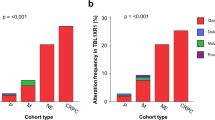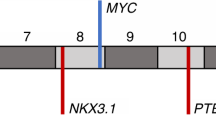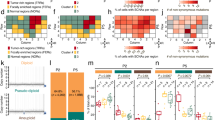Abstract
Loss of heterozygosity (LOH) at 6q16–22 and 10q22.3–23.1 is common chromosomal alteration in advanced prostate cancer and suggests that one or more tumor suppressor genes may lie within these chromosome arms. However, the genetic changes in early stage prostate cancer and premalignant lesions remain to be investigated. We used 11 informative microsatellite markers at 6q16–22 and 10q22.3–23.1 in Japanese patients to compare the frequency of LOH in 53 lesions of high-grade prostatic intraepithelial neoplasia (HGPIN), 38 cases (38 lesions) of incidental prostate cancer (IPC) and 107 cases (168 lesions) of clinical prostate cancer (CPC). The frequency of LOH at 6q16–22 with at least one marker was 38 and 49% in IPC and CPC cases, respectively. Similarly, allelic loss at 10q22.3–23.1 was present in 35 and 39% of IPC and CPC, respectively. High-frequency LOH was detected in both the clinically insignificant and significant prostate cancers at 6q16–22 and 10q22.3–23.1 (P>0.05). However, no allelic loss was detected in any markers at the same regions in HGPIN (0%), which is usually considered a premalignant lesion to prostate cancer. Deletions of both the chromosome regions, 6q16–22 and 10q22.3–23.1, are more likely important events in the initiation and/or promotion of prostate cancer.
This is a preview of subscription content, access via your institution
Access options
Subscribe to this journal
Receive 4 print issues and online access
$259.00 per year
only $64.75 per issue
Buy this article
- Purchase on Springer Link
- Instant access to full article PDF
Prices may be subject to local taxes which are calculated during checkout

Similar content being viewed by others
References
Jemal A, Murray T, Samuels A, Ghafoor A, Ward E, Thum M . Cancer Statistics, 2003. CA Cancer J Clin 2003; 53: 5–26.
Takahashi S, Shirai T, Hasegawa R, Imaida K, Ito N . Latent prostatic carcinomas found at autopsy in men over 90 years old. Jpn J Clin Oncol 1992; 22: 117–121.
Montie JE, Wood Jr DP, Pontes JE, Boyett JM, Levin HS . Adenocarcinoma of the prostate in cystoprostatectomy specimens removed for bladder cancer. Cancer 1989; 63: 381–385.
Kabalin JN, McNeal JE, Price HM, Freiha FS, Stamey TA . Unsuspected adenocarcinoma of the prostate in patients undergoing cystoprostatectomy for other causes: incidence, histology, and morphometric observations. J Urol 1989; 141: 1091–1095.
Revelo MP, Cookson MS, Chang SS, Shook MF, Smith Jr JA, Shappell SB . Incidence and location of prostate and urothelial carcinoma in prostates from cystoprostatectomies: implications for possible apical sparing surgery. J Urol 2004; 171: 646–651.
Winkler MH, Livni N, Mannion EM, Hrouda D, Christmas T . Characteristics of incidental prostatic adenocarcinoma in contemporary radical cystoprostatectomy specimens. BJU Int 2007; 99: 554–558.
Abdelhady M, Abusamra A, Pautler SE, Chin JL, Izawa JI . Clinically significant prostate cancer found incidentally in radical cystoprostatectomy specimens. BJU Int 2007; 99: 326–329.
Carter HB, Coffey DS . The prostate: an increasing medical problem. Prostate 1990; 16: 39–48.
Gittes RF . Carcinoma of the prostate. N Engl J Med 1991; 324: 236–245.
Scardino RT . Early detection of prostate cancer. Urol Clin North Am 1989; 16: 635–655.
Tørring N, Borre M, Sørensen KD, Andersen CL, Wiuf C, Ørntoft TF . Genome-wide analysis of allelic imbalance in prostate cancer using the Affymetrix 50K SNP mapping array. Br J Cancer 2007; 96: 499–506.
Ribeiro FR, Henrique R, Hektoen M, Berg M, Jerónimo C, Teixeira MR et al. Comparison of chromosomal and array-based comparative genomic hybridization for the detection of genomic imbalances in primary prostate carcinomas. Mol Cancer 2006; 5: 33.
Saramaki O, Visakorpi T . Chromosomal aberrations in prostate cancer. Front Biosci 2007; 12: 3287–3301.
Lemeta S, Salmenkivi K, Pylkkanen L, Sainio M, Saarikoski ST, Arola J et al. Frequent loss of heterozygosity at 6q in pheochromocytoma. Hum Pathol 2006; 37: 749–754.
Tzai TS, Chen HH, Chan SH, Ho CL, Tsai YS, Cheng HL et al. Chow NH. Clinical significance of allelotype profiling for urothelial carcinoma. Urology 2003; 62: 378–384.
Bosga-Bouwer AG, Kok K, Booman M, Boven L, van der Vlies P, van den Berg A et al. Array comparative genomic hybridization reveals a very high frequency of deletions of the long arm of chromosome 6 in testicular lymphoma. Genes Chromosomes Cancer 2006; 45: 976–981.
Hu J, Rao UN, Jasani S, Khanna V, Yaw K, Surti U . Loss of DNA copy number of 10q is associated with aggressive behavior of leiomyosarcomas: a comparative genomic hybridization study. Cancer Genet Cytogenet 2005; 161: 20–27.
Nishimura T, Nishida N, Komeda T, Fukuda Y, Ikai I, Yamaoka Y et al. Genome-wide semiquantitative microsatellite analysis of human hepatocellular carcinoma: discrete mapping of smallest region of overlap of recurrent chromosomal gains and losses. Cancer Genet Cytogenet 2006; 167: 57–65.
Sun M, Srikantan V, Ma L, Li J, Zhang W, Petrovics G et al. Characterization of frequently deleted 6q locus in prostate cancer. DNA Cell Biol 2006; 25: 597–607.
Konishi N, Nakamura M, Kishi M, Ishida E, Shimada K, Matsuyoshi S et al. Genetic mapping of allelic loss on chromosome 6q within heterogeneous prostate carcinoma. Cancer Sci 2003; 94: 764–768.
Lu W, Takahashi H, Furusato B, Maekawa S, Ikegami M, Sudo A et al. Allelotyping analysis at chromosome arm 8p of high-grade prostatic intraepithelial neoplasia and incidental, latent, and clinical prostate cancers. Genes Chromosomes Cancer 2006; 45: 509–515.
Lu W, Takahashi H, Furusato M, Maekawa S, Nakano M, Meng C et al. Allelotyping analysis at chromosome 13q of high-grade prostatic intraepithelial neoplasia and clinically insignificant and significant prostate cancers. Prostate 2006; 66: 405–412.
Lu T, Hano H, Meng C, Nagatsuma K, Chiba S, Ikegami M . Frequent loss of heterozygosity in two distinct regions, 8p23.1 and 8p22, in hepatocellular carcinoma. World J Gastroenterol 2007; 13: 1090–1097.
Lu T, Hano H . Identification of minimal regions of deletion at 8p23.1–22 associated with metastasis of hepatocellular carcinoma. Liver Int 2007; 27: 782–790.
Author information
Authors and Affiliations
Corresponding author
Rights and permissions
About this article
Cite this article
Lu, T., Hano, H. Deletion at chromosome arms 6q16–22 and 10q22.3–23.1 associated with initiation of prostate cancer. Prostate Cancer Prostatic Dis 11, 357–361 (2008). https://doi.org/10.1038/pcan.2008.4
Received:
Revised:
Accepted:
Published:
Issue Date:
DOI: https://doi.org/10.1038/pcan.2008.4



